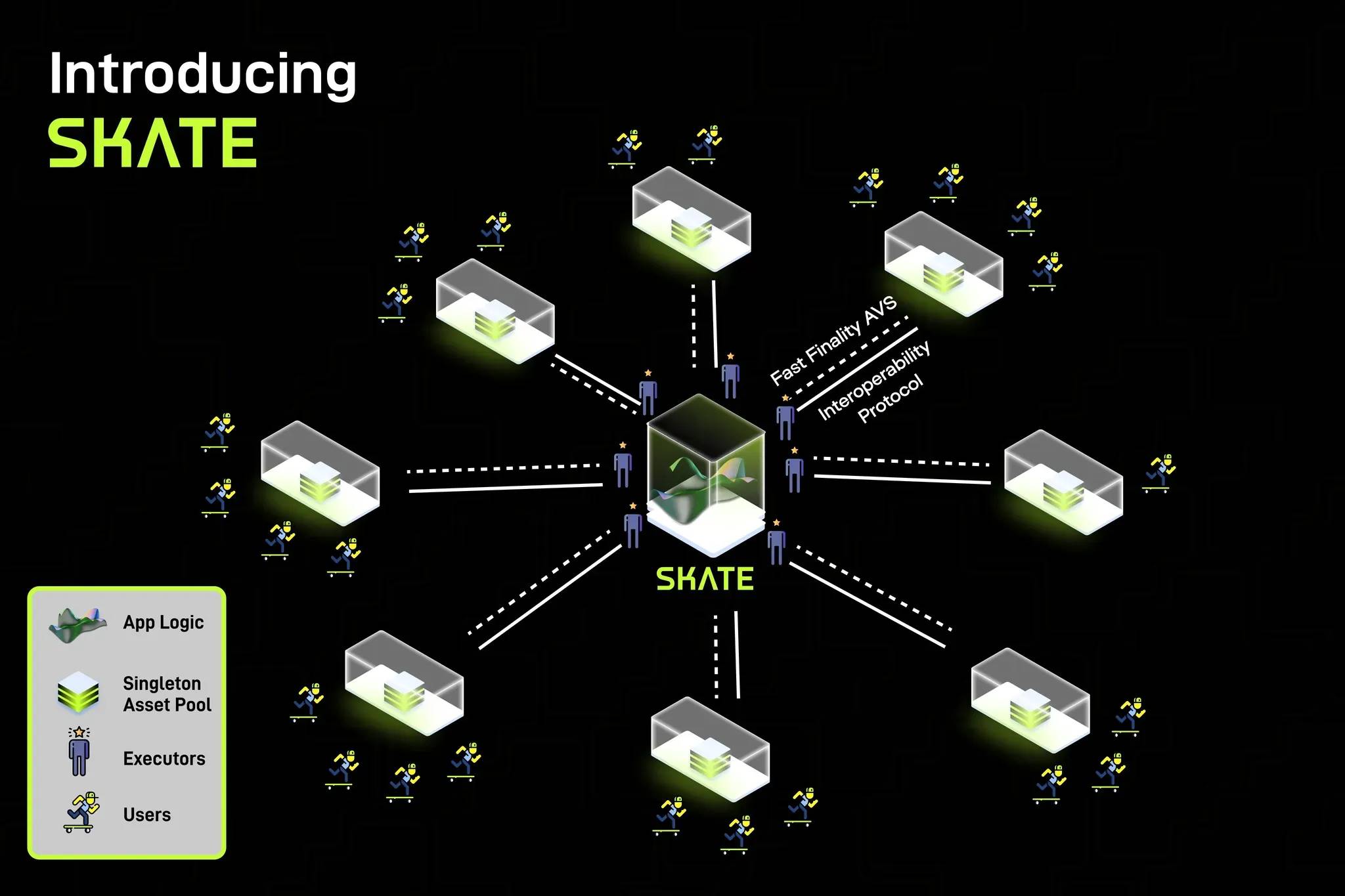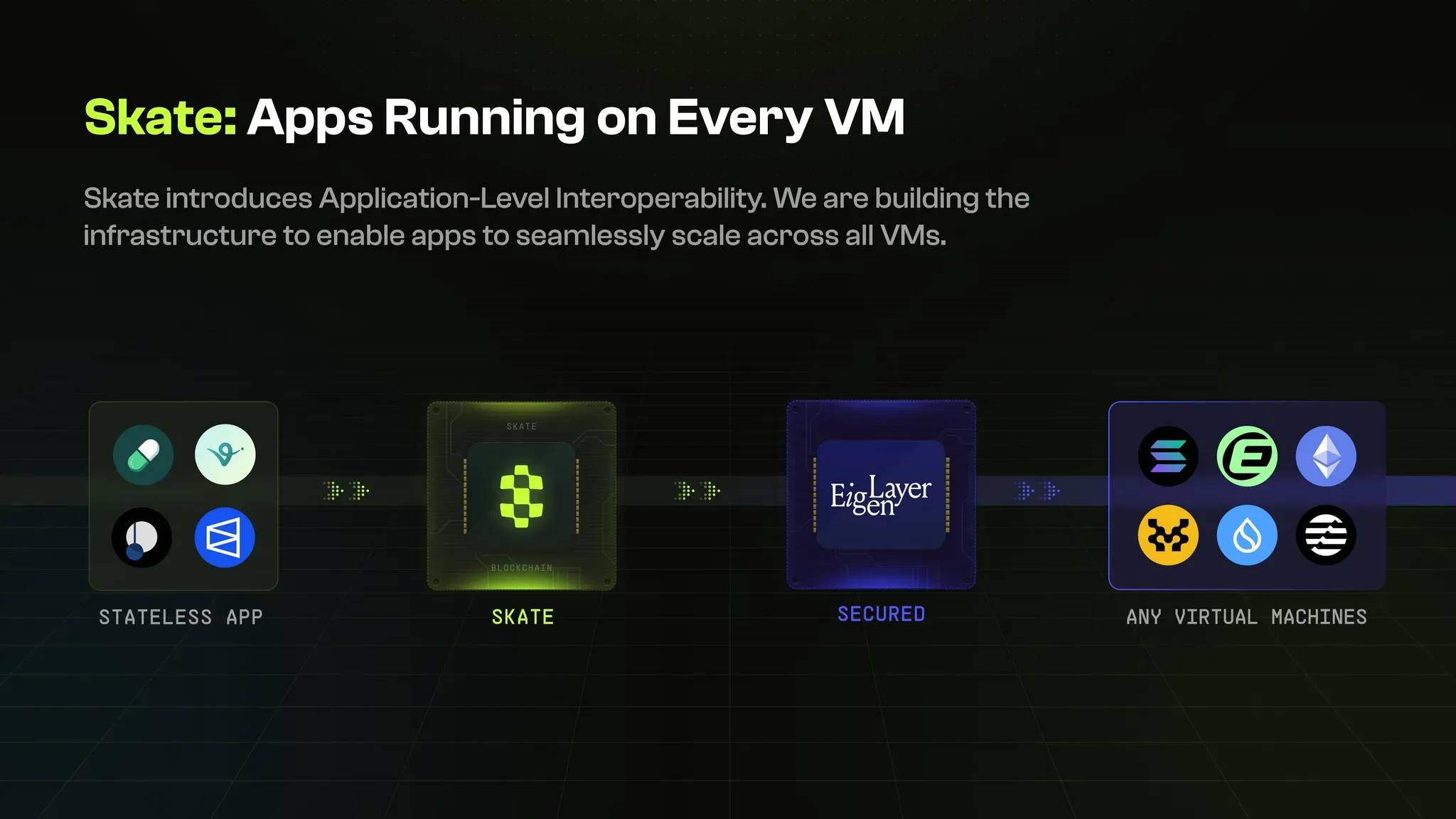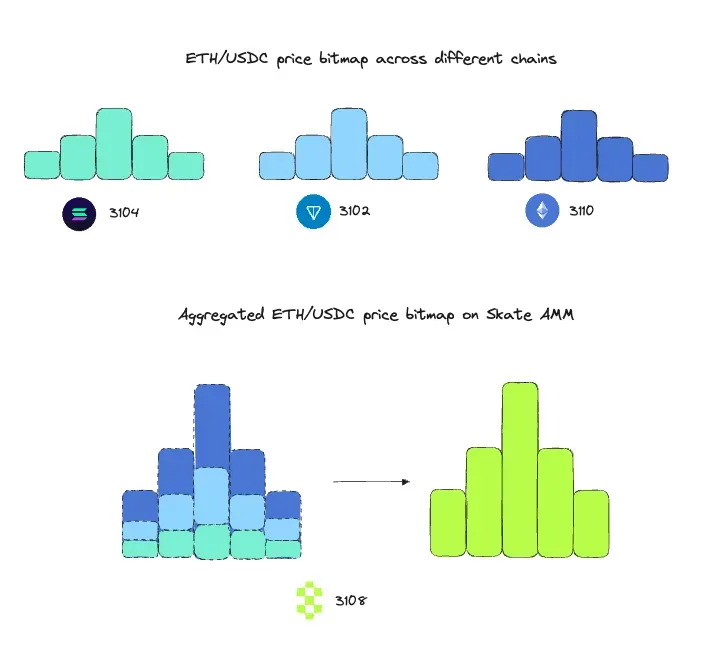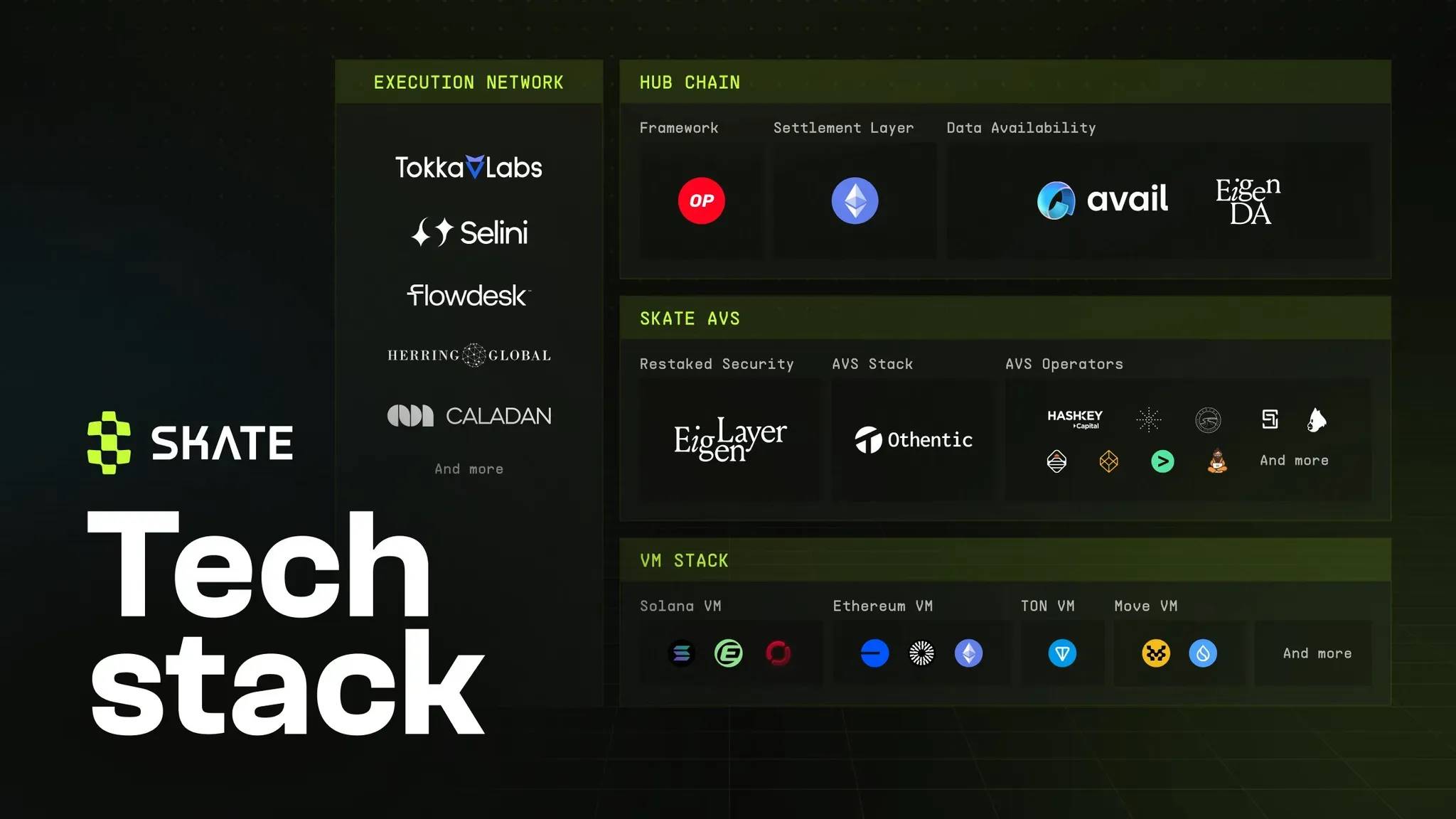Building a Composable Application Stack Across Chains to Create a Stateless Future Beyond Virtual Machines.
Written by: Black Mario
Skate is a stateless, cross-VM infrastructure layer dedicated to providing a unified application logic and liquidity framework for the multi-chain ecosystem. It allows developers to deploy applications once and achieve shared state and logic across multiple chains, significantly reducing development costs and enhancing cross-chain deployment efficiency.
In fact, the current Web3 infrastructure generally suffers from fragmentation, where each chain has its own independent runtime environment and contract system. Developers need to repeatedly write and deploy logic, while users frequently switch between multiple wallets and application interfaces. Skate builds a universal execution environment that synchronizes and coordinates logic, state, and liquidity, allowing cross-chain applications to interact smoothly without the need to migrate or copy state, nor rely on bridging operations.
The core design goal of Skate is to provide a highly composable and scalable runtime framework for on-chain applications without custodial assets or state duplication. Its underlying architecture supports compatibility with various virtual machines such as EVM, Solana, TON, and Move, natively possesses cross-VM coordination capabilities, and ensures security and verifiability during cross-chain processes through stateless execution and the AVS verification mechanism.

With this architecture, Skate provides the infrastructure support for building a unified multi-chain application logic and liquidity network, driving Web3 from "multi-chain deployment" to "inter-chain integration," laying the foundational platform for the next generation of cross-chain DeFi and asset protocols. As one of the important narrative directions that align with the current industry development trends, this project is set to launch its TGE soon and is receiving widespread attention from the market.
Infrastructure Design
The architecture design of Skate revolves around the core principle of "stateless collaboration," aiming to build a runtime system compatible with various virtual machine environments and possessing cross-chain coordination capabilities. Unlike traditional on-chain applications that require deploying and maintaining complete logic and state on each target chain, Skate provides a lightweight coordination layer that is solely responsible for synchronizing intent, scheduling logic, and liquidity, while assets and state remain on the original chain.
Skate's execution model is based on an intent-driven mechanism, where users sign operation intents on the native chain, and executors within the Skate network complete cross-chain operations, with security verification and task scheduling provided by the AVS from EigenLayer. This model eliminates the cumbersome manual cross-chain processes for users, achieving true inter-chain abstraction and seamless interaction.
In terms of system structure, Skate adopts a modular "central-radiating" design, where the central layer uniformly handles application logic, state mapping, and message passing, while execution modules can flexibly connect on each chain side. This design not only achieves compatibility support for EVM and non-EVM networks but also reserves scalable interfaces for future new chain architectures.

Additionally, Skate introduces the concept of global application logic, by hosting a set of cross-chain shared logical states, unifying on-chain calls and state access interfaces, fundamentally solving the deployment burden of "each chain needing to reconstruct applications." The decentralized, stateless, cross-VM coordination model is making Skate a key middleware connecting the multi-chain ecosystem, providing stable system support for composable finance, asset interoperability, and the next generation of cross-chain infrastructure.

Skate AMM: Building the Next Generation Liquidity Engine
Skate AMM is the core product module within the Skate architecture, serving as a unified liquidity engine aimed at solving structural issues such as dispersed asset liquidity, inefficient arbitrage, and inconsistent pricing in multi-chain environments. It connects asset markets across different chains by constructing a cross-VM shared price state system, achieving high coordination in price discovery, arbitrage execution, and fund scheduling.
In traditional cross-chain architectures, liquidity is often divided by chain, leading to pricing deviations and limited market depth for assets on new chains, further weakening capital efficiency for users and protocols. The global Bitmap liquidity model built by Skate AMM incorporates trading pools from different virtual machine environments into a unified view, synchronizing price states with a main chain (such as Ethereum L1) as the anchor point. This structure allows all trades to inherit a unified pricing curve, significantly reducing cross-chain slippage and arbitrage costs.

Skate AMM also possesses automatic rebalancing capabilities, integrating fast cross-chain messaging protocols like Hyperlane to achieve real-time liquidity scheduling across chains, allowing asset distribution to be dynamically optimized based on market demand. This mechanism not only enhances capital utilization but also provides a continuous source of fee income for the protocol.
Specifically at the application layer, Skate AMM provides ideal liquidity support for the cross-chain expansion of stablecoins and real-world assets (RWA). For example, in Plume Network, the native stablecoin pUSD is achieving seamless liquidity coverage across multiple chain ecosystems through Skate AMM, avoiding the need to redeploy liquidity pools while achieving higher pricing efficiency and arbitrage stability.
With its plug-and-play deployment method and unified arbitrage execution path, Skate AMM is gradually becoming the "liquidity operating system" for emerging asset protocols in the multi-chain expansion process, also providing a reliable cross-chain market access layer for DeFi protocols.
Currently, on the eve of Skate's TGE, it has launched an interactive points activity on its AMM DEX, where users can earn points by trading on its AMM DEX, and the points will be redeemable for airdrops during the TGE: https://amm.skatechain.org/swap
Using RWA as a Market Entry Point
Currently, the RWA sector is experiencing an unprecedented development window. By 2025, the total supply of stablecoins has surpassed $240 billion, while the total locked value of RWA protocols has exceeded $25 billion, driven not only by sustained growth in user demand but also by the active participation of traditional financial institutions like BlackRock and Franklin Templeton. This new trend signifies that the on-chain asset market is transitioning from "crypto-native" to "structured and institutionalized."
At the same time, the new generation of stablecoins is exhibiting characteristics of "yield-bearing" and "cross-chain native." More and more protocols are beginning to issue stablecoins linked to off-chain yields and seek to obtain broader use cases through multi-chain deployment. However, in reality, most asset protocols are still constrained by fragmented cross-chain liquidity, severe price deviations, and high deployment costs, hindering their sustainable expansion.
The design of Skate AMM specifically addresses these key pain points by providing structured solutions through a unified pricing system between virtual machines and shared liquidity pools. Skate AMM can significantly enhance the efficiency and credibility of new assets entering the multi-chain market, ensuring price consistency, improving arbitrage stability, and generating native fee income for protocols.
Taking Plume Network's pUSD as an example, this stablecoin was originally issued for a specific ecosystem, making it difficult to achieve efficient expansion without cross-chain liquidity coordination. However, through Skate AMM, pUSD can quickly access a unified liquidity system across multiple chains, avoiding redundant deployments and price slippage, while enhancing liquidity depth and providing Plume with sustainable MEV income and pricing autonomy.
From an application perspective, Skate is gradually becoming the default liquidity infrastructure layer for stablecoins and RWA protocols entering the multi-chain market, facilitating cross-chain growth of asset markets and promoting the formation of "inter-chain capital networks." This new structure will build a more robust and scalable financial foundation for the Web3 world.
Skate AVS: The First System in the EigenLayer Ecosystem to Achieve Actual Usage-Based Protocol Revenue Generation and Redistribution
A key differentiator of Skate from other infrastructure projects is that it not only has a clear technical architecture and application path but has also demonstrated strong market fit and sustainable revenue capabilities in actual operation.
To date, Skate has been successfully deployed in multiple mainstream virtual machine environments, including EVM chains like Ethereum, Base, and BNB Chain, as well as non-EVM networks based on SVM like Solana and Eclipse. These deployments validate Skate's portability and operational efficiency within multi-chain systems and reflect its rapid responsiveness to real user needs.
Reportedly, within just two months of its launch, Skate AMM has accumulated a trading volume exceeding $100 million and completed the first round of protocol fee distribution. The new revenue system is not built through pre-mining or token subsidies but is genuinely based on the fee income generated from on-chain trading activities, marking Skate as the first AVS on EigenLayer with actual protocol revenue recirculation capabilities.
More importantly, these protocol revenues are distributed to AVS re-stakers based on usage on a periodic basis, rather than being statically accumulated, thus forming a sustainable, usage-driven incentive mechanism. This mechanism not only enhances the participation enthusiasm of Skate's operational nodes but also establishes a "real demand-centric" verification service reference paradigm for the entire EigenLayer.

Currently, in the context where the AVS model generally faces "high valuation, low income," Skate provides a replicable template: how to build a sustainable, verifiable protocol revenue system through cross-chain liquidity and high-frequency trading structures. As more DeFi protocols, RWA applications, and on-chain assets connect to Skate, the scale of protocol revenue is expected to continue growing, further enhancing the network effect of the entire system.
Skate is driving a new infrastructure paradigm, a protocol economic model driven by actual trading flow, setting a quantifiable growth path and replicable incentive structure for AVS and modular verification services.
Conclusion
Skate is building a truly cross-chain application infrastructure for the multi-chain world. Through a stateless architecture, AVS security assurance, a unified liquidity engine, and native compatibility with all mainstream virtual machine environments, Skate not only reshapes the technical path for cross-chain interaction but also provides an efficient, composable, and sustainable operational base for stablecoins, RWA assets, and the next generation of on-chain financial protocols.
As Web3 moves into a critical phase of multi-chain collaboration and asset interconnection, Skate's technical framework and product mechanisms have completed the closed-loop verification from concept to implementation. With the integration of more ecological partners and core protocols, Skate will continue to promote the unification of inter-chain logic and liquidity integration, bringing unprecedented infrastructure standards to cross-chain finance and is expected to fundamentally reconstruct the scalability and user experience of Web3.
免责声明:本文章仅代表作者个人观点,不代表本平台的立场和观点。本文章仅供信息分享,不构成对任何人的任何投资建议。用户与作者之间的任何争议,与本平台无关。如网页中刊载的文章或图片涉及侵权,请提供相关的权利证明和身份证明发送邮件到support@aicoin.com,本平台相关工作人员将会进行核查。




